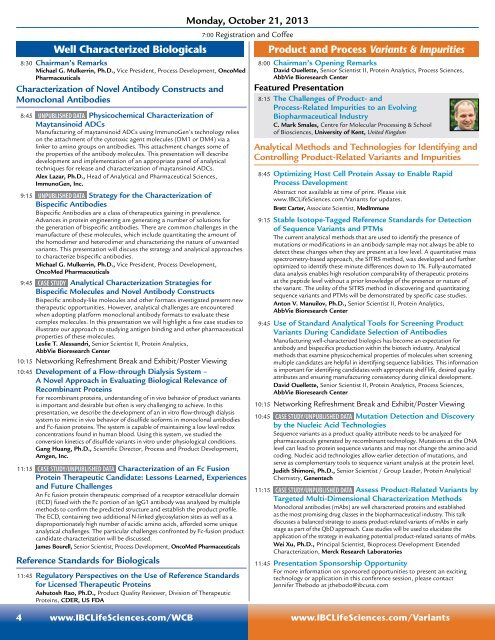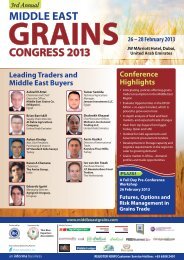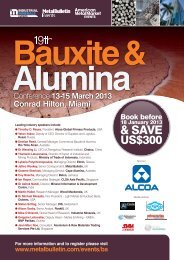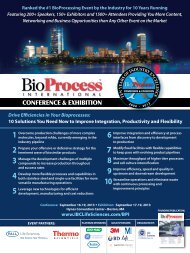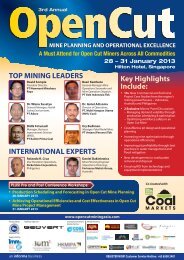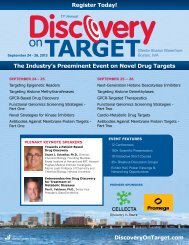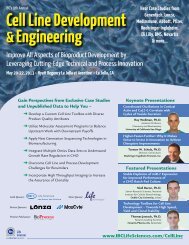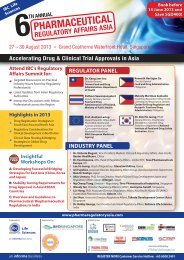Product and Process Variants & Impurities
Product and Process Variants & Impurities
Product and Process Variants & Impurities
You also want an ePaper? Increase the reach of your titles
YUMPU automatically turns print PDFs into web optimized ePapers that Google loves.
Well Characterized Biologicals<br />
8:30 Chairman’s Remarks<br />
Michael G. Mulkerrin, Ph.D., Vice President, <strong>Process</strong> Development, OncoMed<br />
Pharmaceuticals<br />
Characterization of Novel Antibody Constructs <strong>and</strong><br />
Monoclonal Antibodies<br />
8:45 UNPUBLISHED DATA Physicochemical Characterization of<br />
Maytansinoid ADCs<br />
Manufacturing of maytansinoid ADCs using ImmunoGen’s technology relies<br />
on the attachment of the cytotoxic agent molecules (DM1 or DM4) via a<br />
linker to amino groups on antibodies. This attachment changes some of<br />
the properties of the antibody molecules. This presentation will describe<br />
development <strong>and</strong> implementation of an appropriate panel of analytical<br />
techniques for release <strong>and</strong> characterization of maytansinoid ADCs.<br />
Alex Lazar, Ph.D., Head of Analytical <strong>and</strong> Pharmaceutical Sciences,<br />
ImmunoGen, Inc.<br />
9:15 UNPUBLISHED DATA Strategy for the Characterization of<br />
Bispecific Antibodies<br />
Bispecific Antibodies are a class of therapeutics gaining in prevalence.<br />
Advances in protein engineering are generating a number of solutions for<br />
the generation of bispecific antibodies. There are common challenges in the<br />
manufacture of these molecules, which include quantitating the amount of<br />
the homodimer <strong>and</strong> heterodimer <strong>and</strong> characterizing the nature of unwanted<br />
variants. This presentation will discuss the strategy <strong>and</strong> analytical approaches<br />
to characterize bispecific antibodies.<br />
Michael G. Mulkerrin, Ph.D., Vice President, <strong>Process</strong> Development,<br />
OncoMed Pharmaceuticals<br />
9:45 CASE STUDY Analytical Characterization Strategies for<br />
Bispecific Molecules <strong>and</strong> Novel Antibody Constructs<br />
Bispecific antibody-like molecules <strong>and</strong> other formats investigated present new<br />
therapeutic opportunities. However, analytical challenges are encountered<br />
when adopting platform monoclonal antibody formats to evaluate these<br />
complex molecules. In this presentation we will highlight a few case studies to<br />
illustrate our approach to studying antigen binding <strong>and</strong> other pharmaceutical<br />
properties of these molecules.<br />
Leslie T. Aless<strong>and</strong>ri, Senior Scientist II, Protein Analytics,<br />
AbbVie Bioresearch Center<br />
10:15 Networking Refreshment Break <strong>and</strong> Exhibit/Poster Viewing<br />
10:45 Development of a Flow-through Dialysis System –<br />
A Novel Approach in Evaluating Biological Relevance of<br />
Recombinant Proteins<br />
For recombinant proteins, underst<strong>and</strong>ing of in vivo behavior of product variants<br />
is important <strong>and</strong> desirable but often is very challenging to achieve. In this<br />
presentation, we describe the development of an in vitro flow-through dialysis<br />
system to mimic in vivo behavior of disulfide isoforms in monoclonal antibodies<br />
<strong>and</strong> Fc-fusion proteins. The system is capable of maintaining a low level redox<br />
concentrations found in human blood. Using this system, we studied the<br />
conversion kinetics of disulfide variants in vitro under physiological conditions.<br />
Gang Huang, Ph.D., Scientific Director, <strong>Process</strong> <strong>and</strong> <strong>Product</strong> Development,<br />
Amgen, Inc.<br />
11:15 CASE STUDY/UNPUBLISHED DATA Characterization of an Fc Fusion<br />
Protein Therapeutic C<strong>and</strong>idate: Lessons Learned, Experiences<br />
<strong>and</strong> Future Challenges<br />
An Fc fusion protein therapeutic comprised of a receptor extracellular domain<br />
(ECD) fused with the Fc portion of an IgG1 antibody was analyzed by multiple<br />
methods to confirm the predicted structure <strong>and</strong> establish the product profile.<br />
The ECD, containing two additional N-linked glycosylation sites as well as a<br />
disproportionately high number of acidic amino acids, afforded some unique<br />
analytical challenges. The particular challenges confronted by Fc-fusion product<br />
c<strong>and</strong>idate characterization will be discussed.<br />
James Bourell, Senior Scientist, <strong>Process</strong> Development, OncoMed Pharmaceuticals<br />
Reference St<strong>and</strong>ards for Biologicals<br />
11:45 Regulatory Perspectives on the Use of Reference St<strong>and</strong>ards<br />
for Licensed Therapeutic Proteins<br />
Ashutosh Rao, Ph.D., <strong>Product</strong> Quality Reviewer, Division of Therapeutic<br />
Proteins, CDER, US FDA<br />
Monday, October 21, 2013<br />
7:00 Registration <strong>and</strong> Coffee<br />
<strong>Product</strong> <strong>and</strong> <strong>Process</strong> <strong>Variants</strong> & <strong>Impurities</strong><br />
8:00 Chairman’s Opening Remarks<br />
David Ouellette, Senior Scientist II, Protein Analytics, <strong>Process</strong> Sciences,<br />
AbbVie Bioresearch Center<br />
Featured Presentation<br />
8:15 The Challenges of <strong>Product</strong>- <strong>and</strong><br />
<strong>Process</strong>-Related <strong>Impurities</strong> to an Evolving<br />
Biopharmaceutical Industry<br />
C. Mark Smales, Centre for Molecular <strong>Process</strong>ing & School<br />
of Biosciences, University of Kent, United Kingdom<br />
Analytical Methods <strong>and</strong> Technologies for Identifying <strong>and</strong><br />
Controlling <strong>Product</strong>-Related <strong>Variants</strong> <strong>and</strong> <strong>Impurities</strong><br />
8:45 Optimizing Host Cell Protein Assay to Enable Rapid<br />
<strong>Process</strong> Development<br />
Abstract not available at time of print. Please visit<br />
www.IBCLifeSciences.com/<strong>Variants</strong> for updates.<br />
Brett Carter, Associate Scientist, MedImmune<br />
9:15 Stable Isotope-Tagged Reference St<strong>and</strong>ards for Detection<br />
of Sequence <strong>Variants</strong> <strong>and</strong> PTMs<br />
The current analytical methods that are used to identify the presence of<br />
mutations or modifications in an antibody sample may not always be able to<br />
detect these changes when they are present at a low level. A quantitative mass<br />
spectrometry-based approach, the SITRS method, was developed <strong>and</strong> further<br />
optimized to identify these minute differences down to 1%. Fully-automated<br />
data analysis enables high resolution comparability of therapeutic proteins<br />
at the peptide level without a prior knowledge of the presence or nature of<br />
the variant. The utility of the SITRS method in discovering <strong>and</strong> quantitating<br />
sequence variants <strong>and</strong> PTMs will be demonstrated by specific case studies.<br />
Anton V. Manuilov, Ph.D., Senior Scientist II, Protein Analytics,<br />
AbbVie Bioresearch Center<br />
9:45 Use of St<strong>and</strong>ard Analytical Tools for Screening <strong>Product</strong><br />
<strong>Variants</strong> During C<strong>and</strong>idate Selection of Antibodies<br />
Manufacturing well-characterized biologics has become an expectation for<br />
antibody <strong>and</strong> bispecifics production within the biotech industry. Analytical<br />
methods that examine physicochemical properties of molecules when screening<br />
multiple c<strong>and</strong>idates are helpful in identifying sequence liabilities. This information<br />
is important for identifying c<strong>and</strong>idates with appropriate shelf life, desired quality<br />
attributes <strong>and</strong> ensuring manufacturing consistency during clinical development.<br />
David Ouellette, Senior Scientist II, Protein Analytics, <strong>Process</strong> Sciences,<br />
AbbVie Bioresearch Center<br />
10:15 Networking Refreshment Break <strong>and</strong> Exhibit/Poster Viewing<br />
10:45 CASE STUDY/UNPUBLISHED DATA Mutation Detection <strong>and</strong> Discovery<br />
by the Nucleic Acid Technologies<br />
Sequence variants as a product quality attribute needs to be analyzed for<br />
pharmaceuticals generated by recombinant technology. Mutations at the DNA<br />
level can lead to protein sequence variants <strong>and</strong> may not change the amino acid<br />
coding. Nucleic acid technologies allow earlier detection of mutations, <strong>and</strong><br />
serve as complementary tools to sequence variant analysis at the protein level.<br />
Judith Shimoni, Ph.D., Senior Scientist / Group Leader, Protein Analytical<br />
Chemistry, Genentech<br />
11:15 CASE STUDY/UNPUBLISHED DATA Assess <strong>Product</strong>-Related <strong>Variants</strong> by<br />
Targeted Multi-Dimensional Characterization Methods<br />
Monoclonal antibodies (mAbs) are well characterized proteins <strong>and</strong> established<br />
as the most promising drug classes in the biopharmaceutical industry. This talk<br />
discusses a balanced strategy to assess product-related variants of mAbs in early<br />
stage as part of the QbD approach. Case studies will be used to elucidate the<br />
application of the strategy in evaluating potential product-related variants of mAbs.<br />
Wei Xu, Ph.D., Principal Scientist, Bioprocess Development Extended<br />
Characterization, Merck Research Laboratories<br />
11:45 Presentation Sponsorship Opportunity<br />
For more information on sponsored opportunities to present an exciting<br />
technology or application in this conference session, please contact<br />
Jennifer Thebodo at jthebodo@ibcusa.com<br />
4 www.IBCLifeSciences.com/WCB www.IBCLifeSciences.com/<strong>Variants</strong>


